In this article, we will take a look at the relationship between data structures and scopes in Google Analytics 4 (GA4), highlighting their role in accurately analysing website traffic acquisition and conversion attribution across the entire user journey.
GA4 features a 3-layer data structure (User, Session and Event) to organise the data. This data can be analysed through 3 data scopes (with the same names: User, Session, Event), each of which provides a distinct perspective on the data, enabling you to analyse user journeys from different angles.
Relationship between data structure and scopes #
GA4 organise user data like a puzzle
Imagine you’re building a puzzle. GA4 works similarly, organising user data from your website into pieces that fit together to create a complete picture.
In this analogy, the data structure provides the puzzle pieces, while data scopes dictate how they’re analysed and assembled to reveal the whole picture.
Data Structure: The Puzzle Pieces #
The Data structure defines how data is organised within GA4.
The data structure in GA4 is meticulously designed to categorise user data into three primary components (data points), each representing a critical aspect of user interaction on a website.
Think of the data points like the puzzle pieces themselves:
User: the user data point represents individual users, much like identifying each person contributing to completing the puzzle.
Session: the session data point represents the timeframe of a user’s visit, analogous to the time each person spends working on the puzzle.
Event: the event data point captures specific user interactions performed during a session, representing each action or move made in the puzzle’s assembly process.
Transitioning from merely identifying these pieces to understanding how they fit together is where data scopes come into play.
Data Scopes: Assembling the Puzzle #
Data scopes determine which data points are included in an GA4 report.
Thus, while the data structure provides the pieces, data scopes dictate the assembly process, acting as filters, letting you choose specific pieces to analyse.
Selecting a data scope affects the level of detail available in your report. Each scope reveals a distinct viewpoint on the user journey, influencing the insights you can gain:
-
User scope: This scope gives you a long-term view of how individual users behave over time.
Focus on User Journey Over Time
It’s like looking at the puzzle box cover. It gives you an overview of the completed puzzle (the user’s journey over time), but it doesn’t show you the details of how the puzzle was assembled (individual sessions or actions).
Session scope: This scope narrows the focus to a single user’s visit, showing all their actions during that time.
A Specific Section of the User Journey
It’s like analysing one specific section of the puzzle you’re working on, showing you the progress made during that specific period – the parts of the puzzle being pieced together at that moment – but without focusing on the individual moves (events) or the overall picture (user journey).
Event scope: This scope gets super detailed, looking at every single user interaction (like clicks or page views) within a visit.
The Individual Actions during the User Journey
It’s like looking at each puzzle piece (action) individually, understanding its shape, colour, and where it fits within the puzzle, but without showing you the entire session’s progress or the final picture.
Scopes of Dimensions and Metric Calculation #
In Google Analytics a dimension is a descriptive attribute of a visitor to your website – where they came from, their location, which device used etc.
Dimensions describe the data
In GA4, dimensions are tied to specific scopes, affecting their application in reports.
Metrics represent quantitative aspects of your data, expressed in numbers – “how many visits” or “how long a visitor was on the site.”
Metrics measure the data
Metrics don’t have scopes themselves, but they are calculated based on dimensions associated with them. Since dimensions have scopes, these scopes indirectly influence metric calculations.
User-Scoped dimensions #
User-scoped dimensions are attribute associated with individual users and remain constant throughout their browsing sessions.
Examples of user-scoped dimensions in GA:
- User ID: Unique identifier assigned to each user (e.g., “user_12345”).
- User Type: Category of user (e.g., “registered”, “guest”).
- Location: User’s geographical region (e.g., “United States”).
- Language: User’s preferred language setting (e.g., “English”, “Spanish”).
- User Acquisition: Channel through which the user first discovered the platform (e.g., “Organic Search”, “Social Media”).
User-level metrics are calculated based on user-scoped dimensions.
GA4 introduces several changes which affect how the user data are calculated, compared to Universal Analytics:
Shift from Total Users to Active Users
All pre-build reports in Google Analytics 4 reports are based on active users only (not total users).
An active user is defined as either:
Having an engaged session.
Engaged sessions in GA4 are sessions that last longer than 10 seconds, or sessions that have at least 2 pageviews, or sessions that have at least 1 conversion event.
You can adjust the timer for engaged sessions in GA4 by going to Admin > Data Streams > Web Stream > Configure Tag Settings > Show All > Adjust Session Timeout > Adjust timer for engaged sessions.
A new user to the website for the first time.
Active users is a new metric specific to GA4. In Universal Analytics (previous version of GA4) the pre-build reports were always based on total users, regardless of their level of engagement.
However, in GA4 total users metric is still available and can be found in explorations module and BigQuery.
UA
Pre-Built
GA4
Pre-Built
GA4
Exploration
BigQuery
Export
Active Users ❌ ✅ ✅ ✅ Total Users ✅ ❌ ✅ ✅ Reporting Identity
Report identity is a new feature in GA4 that affects how users are calculated within the interface.
There are 3 different calculation methods:
-
Blended, this is the most expansive because taken into account: the device id, the user id (if it’s configured), Google Signals (if it’s enabled) and also any modelling through initiatives like Google consent mode.
The reporting identity is set to Blended by default.
-
Observed, this works similar to blended, but it excludes any model data, So it only looks at device id, user id (if it’s configured) and Google Signals (if it’s enabled).
-
Device-based, this is the less expansive because it only requires GA4 to look at device ID. If GA4 is unable to identify a user based on their device ID, it will then try to identify the user based on their client ID (i.e., first-party cookies) or the app instance ID (for apps).
According to Google: “When you use device-based reporting, Analytics uses the client ID (i.e., first-party cookies) or the app instance ID (for apps), both of which are not subject to data thresholds in reports with user counts.”
Note: The reporting identity allows you to switch between the options at any time without affecting the data stored in GA’s database. Furthermore, reporting identity is applied to both historical and future data.
Data Thresholding
Closely linked to reporting identity data there is data thresholding.
When data could infer the identity of an individual user this is excluded entirely, meaning that reports subject to Thresholding only run on a subset of user data, which affect the accuracy of your data.
Data thresholding is highly prevalent where Google signals data is enabled and the likelihood therefore of user identification increases.
What’s important to know is that data Thresholding is hardcoded. It cannot be switched off or disabled within the GA4 form interface.
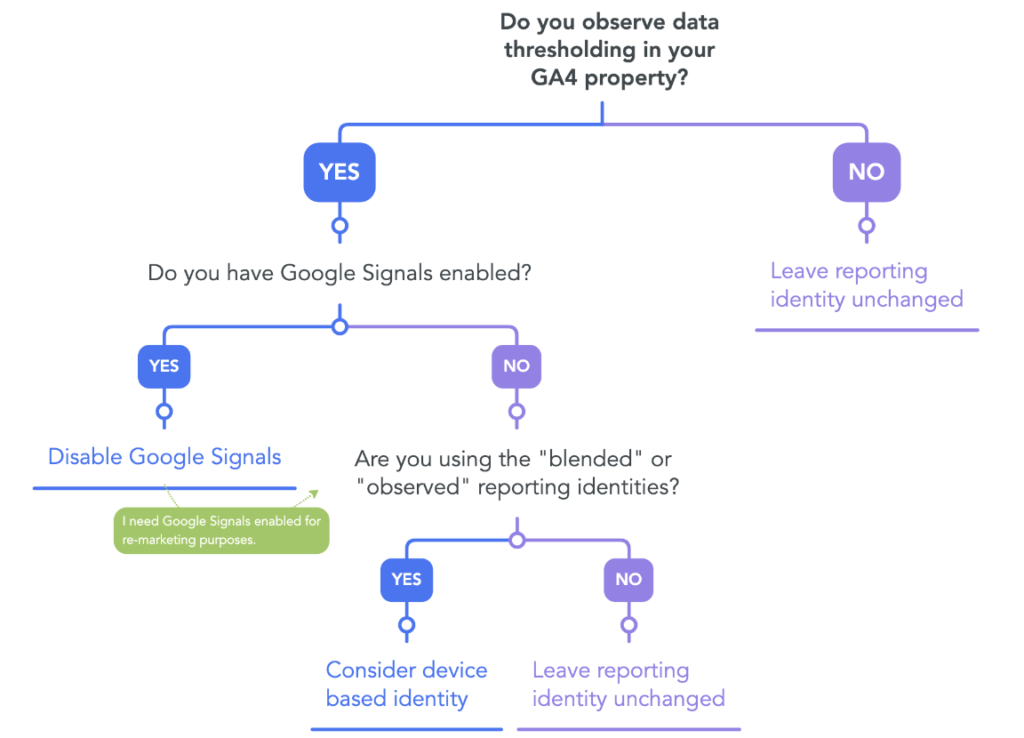
Session scope dimensions #
Session-scoped dimensions capture information specific to individual user visits (sessions) to your website or app.
How users behave during a particular visit
Unlike user-scoped dimensions which remain constant, session-scoped dimensions can change for each new visit.
Examples of sessions-scoped dimensions in GA:
- Session Source: Channel (e.g., organic search, social media) through which a user accessed your platform within that session.
- Session Campaign: Specific marketing campaign associated with the user’s visit (if applicable).
- Landing Page: The first page a user viewed during that session.
- Previous Page: The page the user visited before the current page within the same session.
- Time of Day: The specific time the user initiated the session.
Session-level metrics are calculated based on session-scoped dimensions
GA4 introduces several changes in how a session is defined which affect how the session data are calculated, compared to Universal Analytics:
-
GA4 no longer splits sessions based on changes in traffic
When source, medium or campaign changes mid-session, a new session does not begin.
Unlike its predecessor, GA4 no longer splits sessions but prioritises the first traffic source for attribution. This means that when a user interacts with multiple sources within a single session, GA4 credits the initial traffic source.
From one side this represent an improvement over Universal Analytics that fixes a well-known issue where, for example, incorrect UTM tagging or single-page app behaviour can both destroy attribution and significantly inflate session data.
However, from another side, causes another challenge, due to subsequent interactions, like clicking an organic search result after a paid ad, might not be reflected in the reports.
We’ll will come back later on, when we discussed about session-scoped traffic dimensions
-
New sessions does not begin at midnight
The session counting logic has been updated for sessions that cross from one day to the next.
So let’s take this example where a user lands at five to midnight on the site and then they leave the site at five minutes past midnight and we’ve crossed the day.
In universal analytics when a session crosses two days would automatically start a brand new session at midnight, which essentially inflates the session count. So that journey would be represented in UA as two sessions.
In Google Analytics 4 this scenario is counted as a single session count.
UA GA 4 User lands 23:55 on 1st October
User leave 00:05 on 2nd October
1st Oct: 1 session
2nd Oct: 1 session
1st Oct: 1 session Total sessions reported 2 1 Late hit processing have been extended to 72 hours
What do I mean by late hit processing? Let’s say a user visits your site on a mobile device and whilst the visiting user loses the mobile signal, effectively ending the visit, but then the user revisits the site when their mobile signal returns.
Now the gap between the second and third points here is really important.
Within Universal Analytics, the processing window was 4 hours, which means the difference between losing the signal and returning of signal, if that happens within four hours or less, universal analytics would process that as a late hit.
With GA4 that time has now extended out to 72 hours.
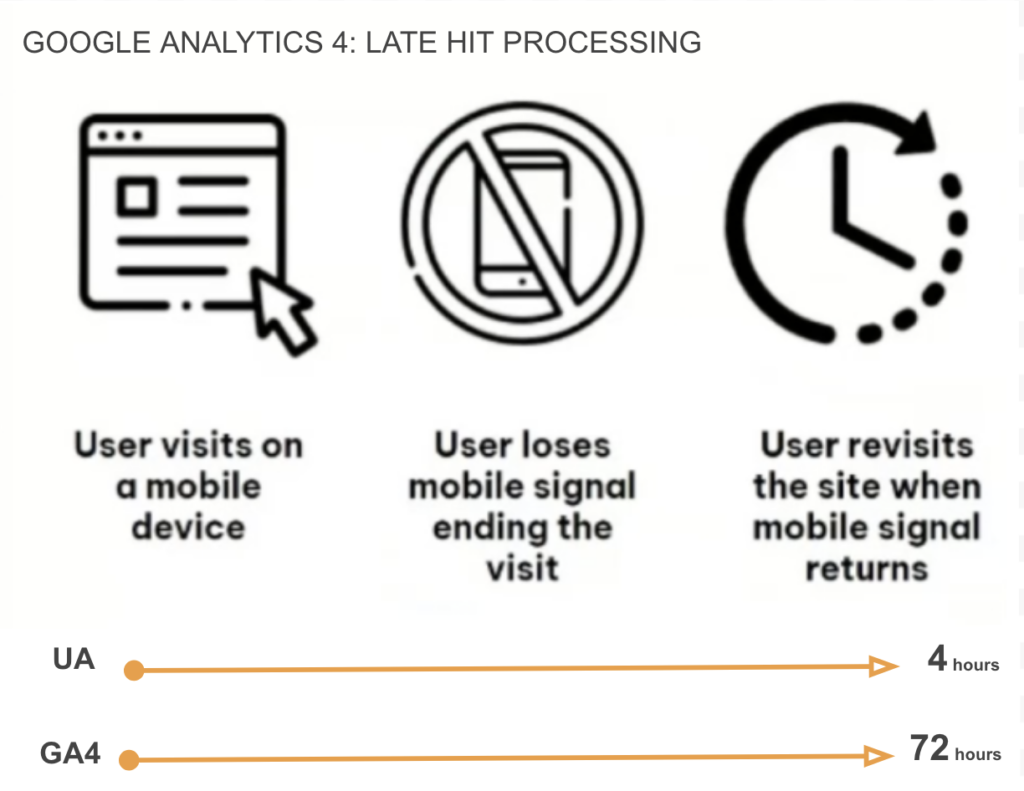
Event scope dimensions #
Event-scoped dimensions focus on individual events within a user’s session.
This allows conducting in-depth analyses of user behaviour (the specific actions users take) and the performance of specific content (how they engage with your content) within your site or app.
Examples of event-scoped dimensions in GA:
Event Name: Identifies the action (e.g., “add_to_cart”).
Event Category: Groups similar events (e.g., “Ecommerce”).
Event Label: Provides additional context (e.g., Downloaded file name).
Event Action: Describes the action within an event (e.g., ‘added’).
Event Value: Captures a numeric value (e.g., Time spent on a page).
Page Path + Query String: Context of user actions (e.g., URL of the page where the event occurred).
These dimensions are calculated for each individual event, meaning their values can change with every user action.
Scopes of traffic-source dimensions #
GA4 Scopes play a crucial role in analysing user acquisition and attributing conversions accurately.
Google Analytics categorises traffic sources using three dimensions:
- Source: where your traffic originates (e.g., google, bing).
- Medium: the methods by which users arrive at your site/app (e.g., organic, cpc).
- Campaign: the specific marketing efforts you use to drive that traffic (e.g., campaign, creative format, keywords).
In Universal Analytics (UA), these three traffic source dimensions were solely session-based.
Google Analytics 4 (GA4) introduced user, session, and event scopes for traffic source dimensions.
In Google Analytics 4 (GA4) each traffic sources dimensions has a scope that defines the user acquisition (Where a user came from?) and the conversion attribution (Which touchpoints drove the conversion?) in a slightly different way.
So, understanding a traffic dimension’s scope — knowing whether it’s at the user, session, or event scope — is crucial for effective analysis.
How can I identify Traffic Dimension Scopes?
GA4 simplifies this by incorporating prefixes, so you can quickly identify whether a traffic dimension belongs to the user, session, or event scope.
User scoped traffic dimensions come with the prefix ‘First user’.
Session scoped traffic dimensions are prefixed with ‘Session’
Event scoped dimensions do not include a ‘first user’ or ‘session’ prefix in their description.
User Scoped
(New user acquisition)
Session Scoped
(New & returning user)
Event Scoped
(Interactions)
First user default channel group
First user campaign
First user campaign ID
First user source
First user source/medium
First user medium
Session default channel group
Session campaign
Session campaign ID
Session source
Session source / medium
Session medium
Default Channel Group
Campaign
Campaign ID
Source
Source/medium
Medium
‘First user’ prefix ‘Session’ prefix No prefix Example:
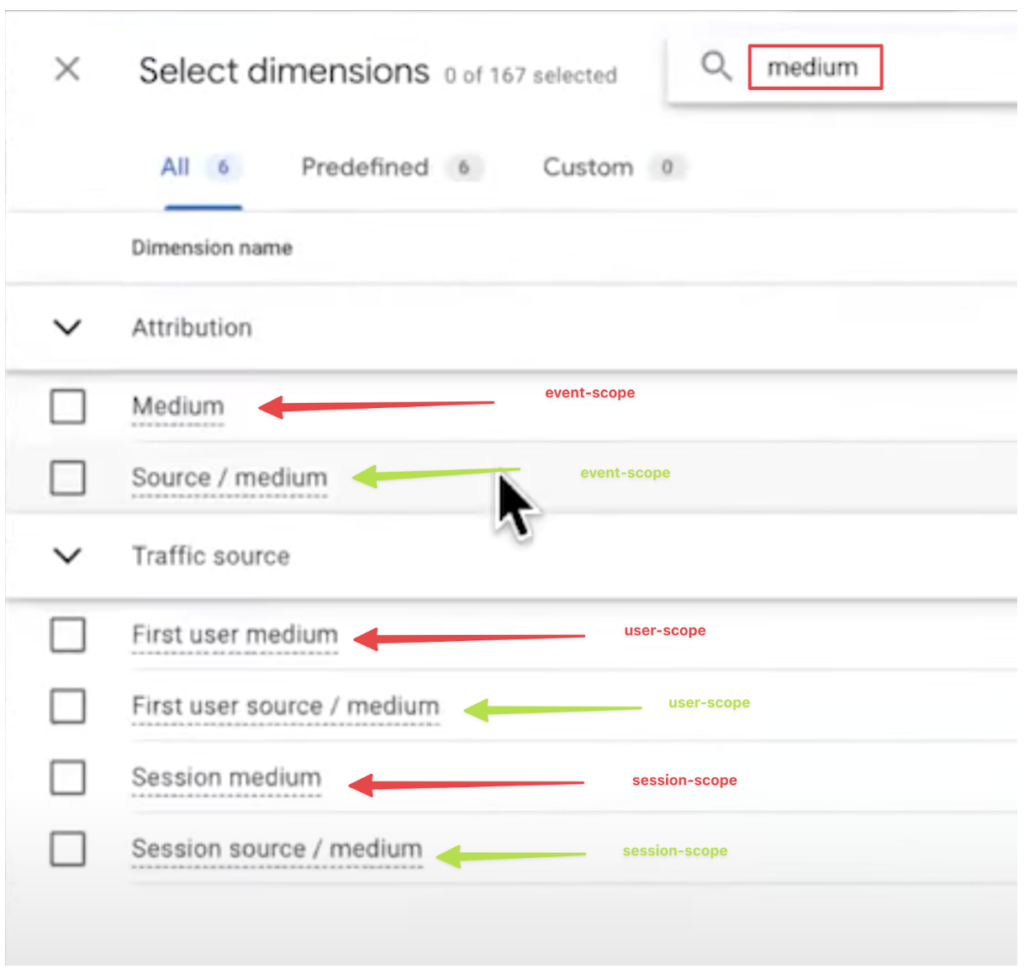
How user, session, and event scopes differ in their approach to user acquisition and conversion attribution for each dimension?
“For user-scoped and session-scoped dimensions, Analytics uses the paid and organic channels last click attribution model. User-scoped and session-scoped dimensions are unaffected by changes to the attribution model.
For event-scoped dimensions, Analytics uses the attribution model that you select, but by default, Analytics uses the data-driven attribution model. All reports with event-scoped traffic dimensions reflect the attribution model you select.”
Note: All attribution models exclude direct traffic from receiving attribution credit unless it’s the only source in the path.
Here a table summary:

Source / Medium
scope
Purchase
attributed to…
User reporting attribution
model in GA4 admin
First User Google Organic ❌ Session Paid Search ❌ Event Google Organic & Google Paid ✅ Let’s see in details each traffic dimension scope.
User-scoped traffic dimensions #
Where They Came From First
Look at the initial acquisition – where did they come from the very first time they engaged?
The standard user acquisition report in GA4 interface relies on user scoped dimensions.
Objective:
User-scoped dimensions (e.g., First user source, etc.) focus on the user’s initial acquisition point, regardless of subsequent interactions or the chosen attribution model.
They simply identify the very first channel (e.g., organic search, social media) that brought the user to your site or app for the first time, allowing to see which initial traffic sources are driving users towards conversions.
Example:
A new user sees your ad on social media (first touchpoint) but doesn’t click. Later, they find your site organically, then click on a Google ad and complete a purchase.
Acquisition attribution:
In this example, the user does not interact with social media ads (meaning they do not click on it), so the user scope identifies the organic channel as the “first user source” due to being the initial point of engagement.
User-scoped dimensions remain consistent even when the user returned to the site through Paid ad.
As mentioned previously, GA4 does not split sessions when a user interacts with multiple sources.
So we need to distinguish 2 scenarios:
The user interacted with the paid ad within the same session.
The user interacts with the paid ad in a new session.
If the paid ad interaction happened in the same session as the organic visit, GA4 will combine them into a single session attributed to organic.
Thus, in the GA4 user acquisition report will have one session attributed to organic.
If the paid ad interaction happened in a new session, GA4 will create two separate sessions, both attributed to organic.
Thus, in the GA4 user acquisition report will have two sessions, both attributed to organic (despite the user interacted with a paid ad).
Event attribution:
For user-scoped Google Analytics 4 uses the paid and organic channels last click attribution model.
However there is a twist!
Even though “First source / medium” is a user-scoped dimension, it operates differently from the Last Non-Direct Click attribution model. Instead of attributing the conversion to the last non-direct interaction the user had before converting, “First source / medium” attributes the conversion back to the very first interaction that brought the user to your site, regardless of the subsequent interactions.
Therefore, for example, if you place the Event Count Metric “purchase” next to this dimension (as showed in the image below), you will get the number of USERS who first arrived from this traffic source, and performed a purchase event during the selected time.
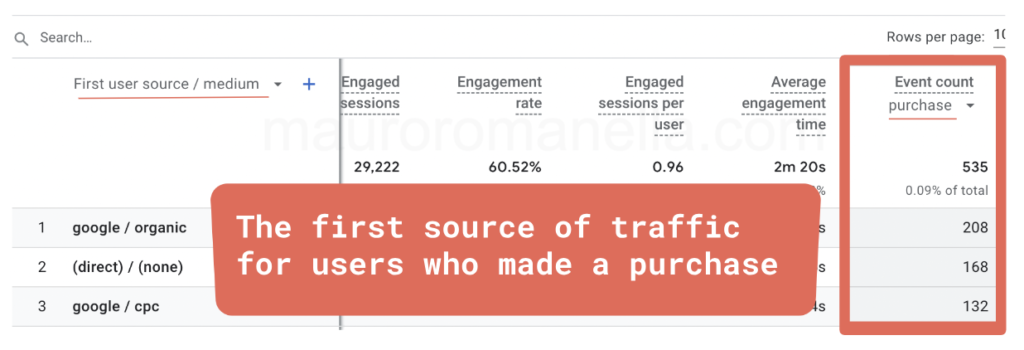
208 people who bought something found your store by searching Google Organic first.
These 208 people didn’t necessarily buy on their first visit, or even come back through Google. It just shows they discovered you through Google Organic first.
Having 208 purchases from Google searches could be a good sign! It suggests Google searches bring in people likely to buy.
Note: User-scoped dimensions are not affected by the overall attribution model setting in GA4.
Session-scoped traffic dimension #
Where They Came From This Time
Focuses on the initial traffic source for a session – where did they come from for this particular visit?
They simply identify the channel that led to the particular session. So, it includes both: new and returning users.
For this reason, you should expect to have more events and conversions count compared to user-scoped report (that focuses on new users only).
The standard traffic acquisition report in the GA4 interface is based on session scoped dimensions.
Objective:
This report shows the first traffic source of each individual session.
This allows you to understand which channels are most effective at driving traffic to your site on a session-by-session basis.
Example:
An user:
Starts with Organic Search.
Interacts with Paid Search later.
Finally, return directly and convert.
Acquisition attribution:
The acquisition channel is determined based on the first user interaction (e.g., page view) within a session.
Again, GA4 does not split sessions when a user interacts with multiple sources.
So we need to distinguish 2 scenarios:
The user interacts with multiple sources within the same session.
Starts with Organic Search.
Interacts with Paid Search later in the same session.
Finally, in the same session, return directly and convert.
GA4’s standard report would solely credit the initial source, Organic Search, despite the user also interacting with a Paid Search ad and direct.
-
The user interacts with multiple sources across different sessions.
Starts with Organic Search.
Interacts with Paid Search later in a new session.
Finally, in a new session, return directly and convert.
Each session’s initial traffic source is recognised separately: 1 session Organic, 1 session Search Paid search and 1 session direct.
Note: The first case scenario shows the limitation (overlooking subsequent interactions within the same session) while the second case shows the strength (handling multiple traffic sources across sessions) in GA4’s attribution.
Event attribution:
For event-scoped dimensions, GA4 uses the last non-direct click model for attributing conversion.
This model credits the last known referral source that led the user to the website before conversion, excluding direct traffic unless it’s the only source.
So, when paired with a metric like Event count (e.g., purchase), you will get the number of SESSIONS that came from this traffic source, and performed a purchase event during the selected time.

There are 259 people who arrived through an Google Organic Search session and triggered the purchase event.
The “Session source/medium” vs “First user source/medium” event count discrepancy
First user source/medium: use the “first click” attribution model, gives credit to the very first source through which the user initially discovered the website, regardless of how many sessions they had before making a purchase.
Session source/medium: use the “Paid and Organic Last Click” (also known as “Last Non-Direct Click”) attribution model, attributes the purchase to the source of the user’s current session.
So, the difference in event (e.g., purchase) numbers suggests that some users might discover the site through one source but make a purchase with another source.
For instance, a user might initially find the site through an Google Organic Search but return later in a new session by clicking on a Google Paid Ad to make the purchase.
First user source/medium attribute the purchase to Google Organic.
Session source/medium attribute the purchase to Google Paid.
Similar to user-scope, Session-scoped dimensions are unaffected by the property’s overall attribution model setting.
Event-scoped
trafficdimensionHow many conversion generated each channel
The term “event-scoped traffic dimensions” it’s not accurate in the context of GA4. Traffic dimensions in GA4 refer to aspects related to user acquisition while event-scoped dimensions focus on actions users take on the site after they arrive (events), not where they came from (traffic source).
The standard conversion report in the GA4 interface is based on event scoped dimensions.
Even if the report shows Total users you will not see all the users who came from each of the traffic sources, but only the users who converted.
In other words, while the report shows Total Users, it won’t include all users from each traffic source. It only reflects users who converted.
The source and medium for non-conversion events are “(not set)”.
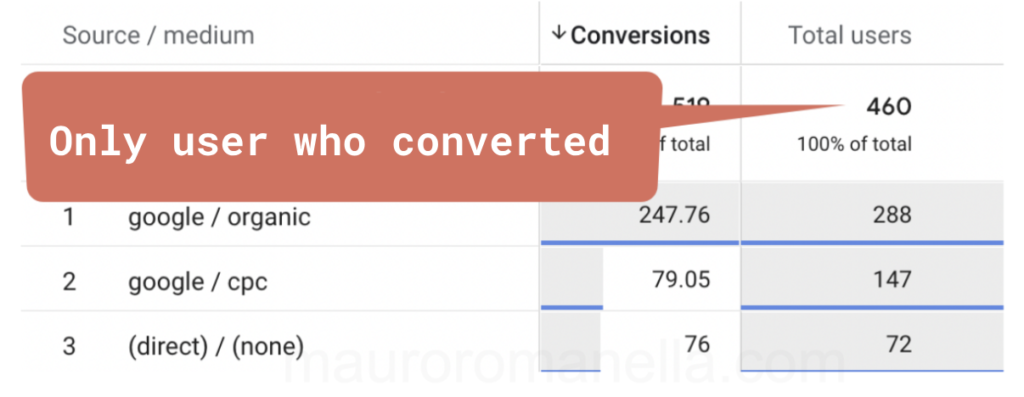
There are 288 people who came from “google / organic” source/medium and converted.
Objective:
The source / medium event scope shows how many conversions came from each traffic source, according to the attribution model you chose in the property’s settings.
Conversion attribution:
For event-scoped dimensions, Analytics uses the attribution model that you select, but by default, Analytics uses the data-driven attribution model, which distributes credit for conversions across multiple touchpoints that led to the conversion.
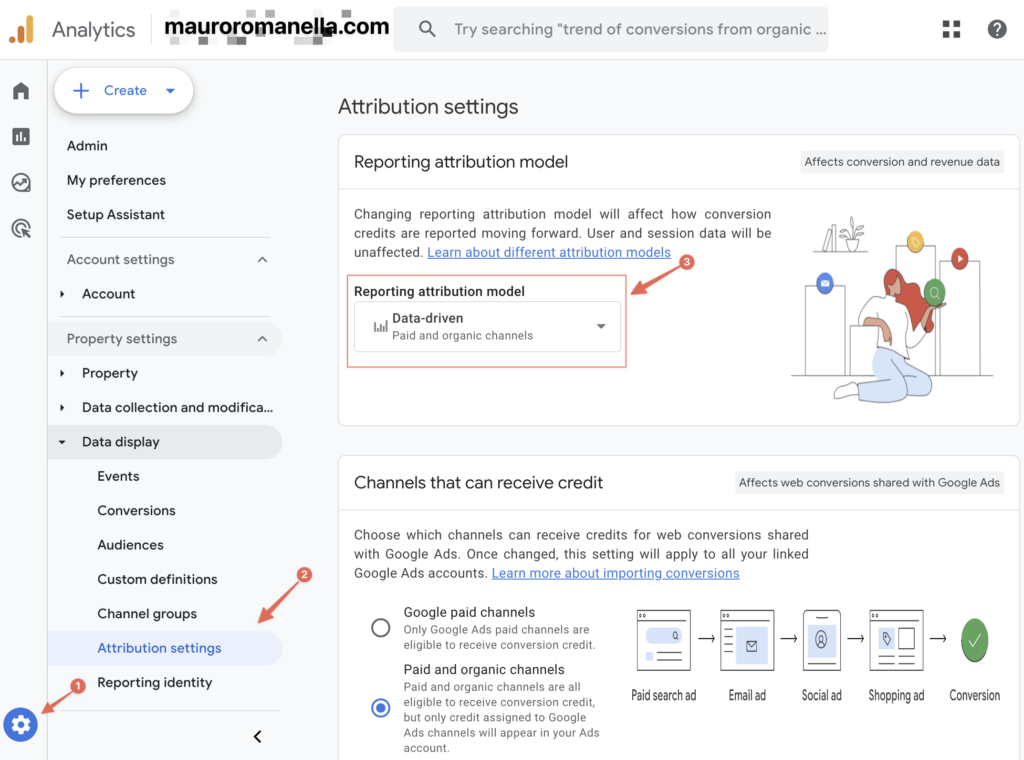
This approach acknowledges that a user’s path to conversion can involve multiple interactions across different channels, and it aims to more accurately reflect the contribution of each channel to the conversion process.
For this reason, the conversions are not a whole number.
Please note that there is no option to select the Ecommerce purchases metric, but only Conversions, because that is the whole purpose of this dimension – to give you information that takes into account several sources of traffic, and not just the first or the last.
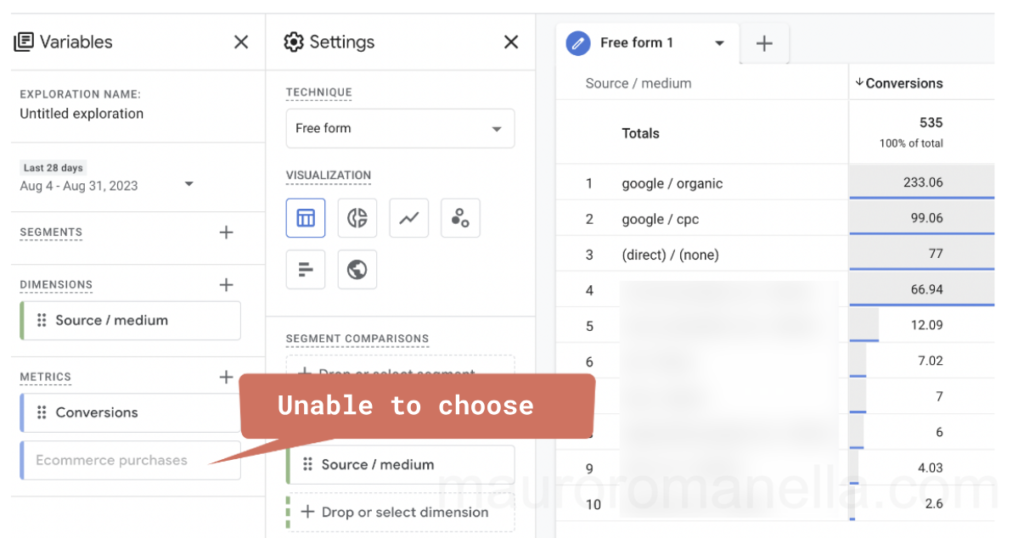
Reference and Useful Links #
- [GA4] Scopes of traffic-source dimensions Link
